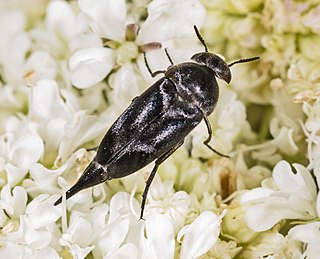Related Research Articles

The Mordellidae are a family of beetles commonly known as tumbling flower beetles for the typical irregular movements they make when escaping predators, or as pintail beetles due to their abdominal tip which aids them in performing these tumbling movements. Worldwide, there are about 1500 species.

Mordella is the type genus of the tumbling flower beetle family (Mordellidae), its subfamily Mordellinae and the tribe Mordellini. It is widely distributed in the Holarctic and adjacent regions. The larvae are primarily dead wood borers.

Mordella aculeata is a species of beetle in the genus Mordella of the family Mordellidae, which is part of the superfamily Tenebrionoidea. It was discovered in 1758.

Mordellinae is a subfamily of beetles commonly known as tumbling flower beetles for the typical irregular movements they make when escaping predators, or as pintail beetles due to their abdominal tip which aids them in performing these tumbling movements.
Mordella thoracica is a species of beetle in the genus Mordella of the family Mordellidae, which is part of the superfamily Tenebrionoidea. It was discovered in 1851.
Mordella albomacaculata is a species of beetle in the genus Mordella of the family Mordellidae, which is part of the superfamily Tenebrionoidea. It was first described by Hippolyte Lucas in 1857.
Mordella insidiosa is a species of beetle in the genus Mordella of the family Mordellidae, which is part of the superfamily Tenebrionoidea. It was first described by Hippolyte Lucas in 1849.
Mordella subuniformis is a species of beetle in the genus Mordella of the family Mordellidae, which is part of the superfamily Tenebrionoidea. It was discovered in 1937.
Mordella festiva is a species of beetle in the genus Mordella of the family Mordellidae, which is part of the superfamily Tenebrionoidea. It was discovered in 1895.
Mordella tristis is a species of beetle in the genus Mordella of the family Mordellidae, which is part of the superfamily Tenebrionoidea. It was discovered in 1895.
Mordella knulli is a species of beetle in the genus Mordella of the family Mordellidae, which is part of the superfamily Tenebrionoidea. It was discovered in 1922.
Mordella ignaciosa is a species of beetle in the genus Mordella of the family Mordellidae, which is part of the superfamily Tenebrionoidea. It was discovered in 1936.
Mordella calodema is a species of beetle in the genus Mordella of the family Mordellidae, which is part of the superfamily Tenebrionoidea. It was discovered in 1917.

Mordella atrata is a species of beetle in the genus Mordella of the family Mordellidae, which is part of the superfamily Tenebrionoidea. It was discovered in 1845.
Mordella dodonaeae is a species of beetle in the genus Mordella of the family Mordellidae, which is part of the superfamily Tenebrionoidea. It was discovered in 1860.
Mordella defectiva is a species of beetle in the genus Mordella of the family Mordellidae, which is part of the superfamily Tenebrionoidea. It was discovered in 1859.

Mordella holomelaena is a species of beetle in the genus Mordella of the family Mordellidae, which is part of the superfamily Tenebrionoidea. It was discovered in 1914.
Mordella inclusa is a species of beetle in the genus Mordella of the family Mordellidae, which is part of the superfamily Tenebrionoidea. It was discovered in 1813.
Mordella insulata is a species of beetle in the genus Mordella of the family Mordellidae, which is part of the superfamily Tenebrionoidea. It was discovered in 1859.
Mordella lapidicola is a species of beetle in the genus Mordella of the family Mordellidae, which is part of the superfamily Tenebrionoidea. It was discovered in 1909.
References
- ↑ Lucas, H. (1857) [1859]. "Mordella pleurosticta, Luc.". Entomologie. Expédition dans les parties centrales de l'Amérique du Sud. Vol. 7 Partie: Zoologie. Paris: P. Bertrand. p. 144.
- ↑ Mordellidae Species List at Joel Hallan's Biology Catalog. Texas A&M University, archived from the original on 7 October 2014, retrieved 9 August 2015